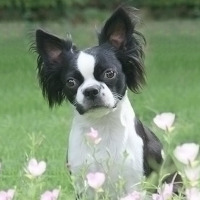Appearance of the French Buillon
|
| This specific cross-breed of dog will have a look with similarities between the French Bulldog and the Continental Toy Spaniel. French Bulldogs are small but sturdy dogs with large ears that are often described as bat-like. Their nose resembles that of a Pug and their head is flat and not too large with a rounded forehead. Their skin is soft and loose, and they have straight or corkscrew tails. This breed will have teeth that meet in an underbite and large, round eyes. The dog as a whole is square-shaped, with approximately the same height at the withers as the length to the tail. Width-wise, the French Bulldog looks a little like a pear, with shoulders wider than the rear. The Continental Toy Spaniel is tiny and finely boned. Their expressions show intelligence and alertness. These dogs have the butterfly ears that give them their name, which can be erect or drooping, in which case the dog would be considered Phalene as opposed to Papillon. Their ears have a long fringe and the tails are feathered. These dogs have fine, tapering muzzles that are thin in relation to the head. This breed has alert eyes that will be round and medium-sized. The topline will be level with the neck of medium length. |
Temperament of the French Buillon
|
| As with appearance, the French Buillon will share personality traits with each of its parent breeds. It can develop temperamental habits from the French Bulldog, which is said to be one of the world's best pets. These dogs are well-behaved and get along well with any person or animal. They are easy to handle but can be mischievous and demand attention, as they love to feel loved by their humans. For this reason, they can develop separation anxiety and should not be left alone for long periods. They can sometimes be difficult to train, as they are known to be stubborn and can get bored with repetition. Win them over with treats and love, as opposed to force and anger. The Papillon breed is intelligent and easy to train. They also love to receive attention and spend time with their human companions, and are very good with children. To raise a calm, obedient and confident French Buillon, train it correctly and socialize it as a puppy. |
Needs and activities of the French Buillon
|
| French Bulldogs do best with several short walks a day, as well as some play time. Their activity time should be reduced during the summer when it's very hot, as they can get heatstroke. Don't try to cool them down by swimming, as this breed doesn't swim naturally and can drown unaided in water. Always supervise a French Bulldog near a swimming pool. The Papillon has a lot of energy compared to the French Bulldog and will need more daily exercise. They also need to be exercised mentally, not just physically. Agility or interactive games are a good way to do this. The French Buillon will probably have a moderate need for exercise and may have bursts of energy, as well as a love of downtime. |
Maintenance of the French Buillon
|
| The French Buillon's French Bulldog side is easy to care for. They have simple coats that don't need clipping and are brushed only once a week. This breed doesn't need to be bathed often, and when it does, the task is simple. The Papillon's long, silky coat may seem high-maintenance, but it's actually easy to maintain. These dogs should be brushed two or three times a week, but don't need scheduled baths. Although this breed can benefit from occasional trimming, it's a fairly easy task and doesn't require the help of a professional groomer. Your French Buillon's coat may be a uniform blend between parents or could be short if French Bulldog genes are prominent, and in turn, long if Papillon traits are stronger. Clean your dog's ears regularly to avoid ear infections, which should be done about once a month. You also need to keep your dog's teeth and gums healthy, which means brushing every day, or at least two or three times a week. Regularly trim your dog's nails too. They should be checked and groomed every one or two months. |









 English (United Kingdom)
English (United Kingdom)